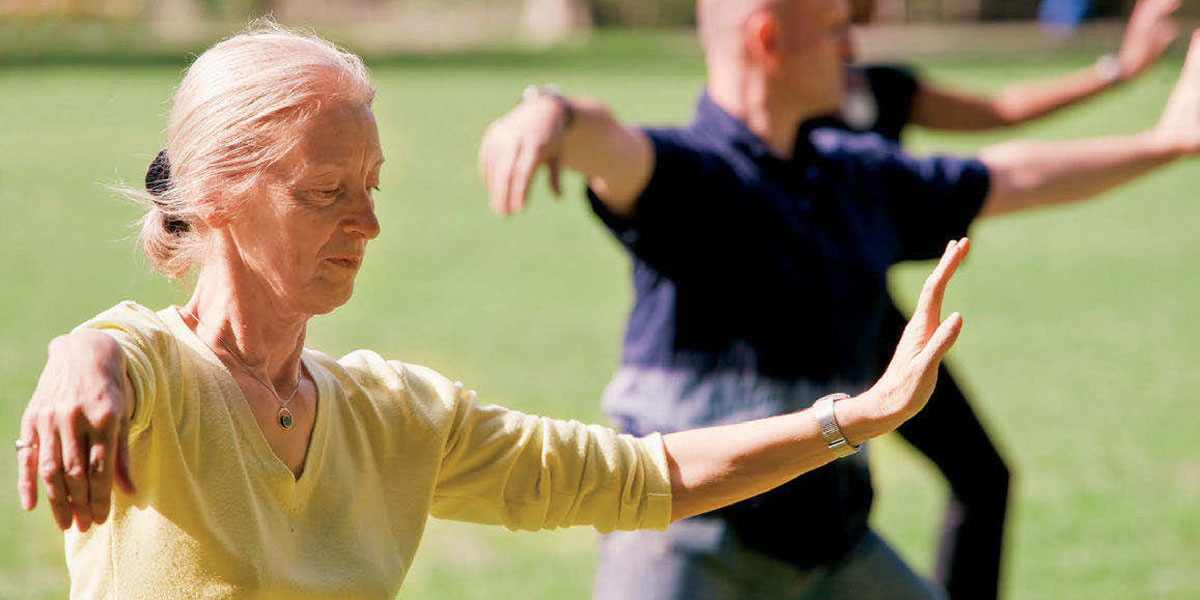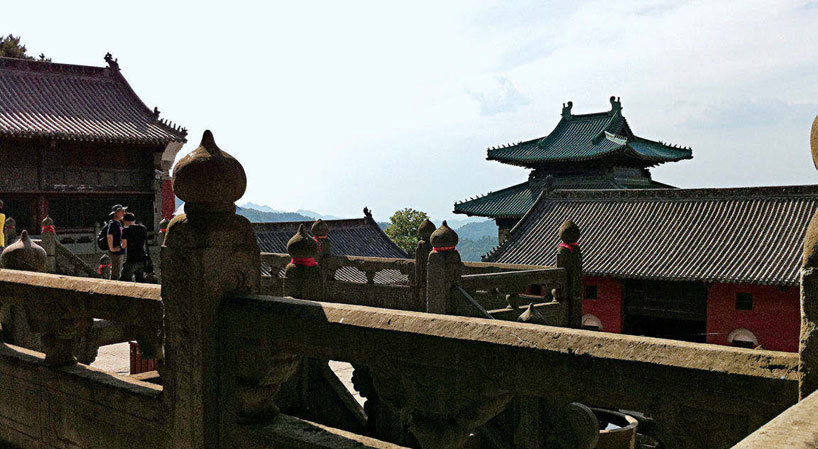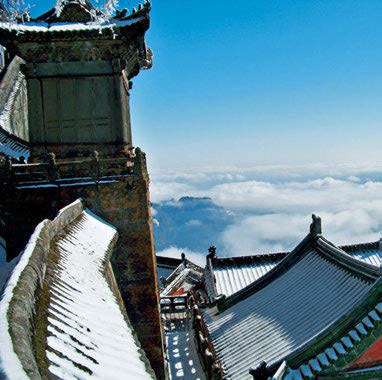

Tai Chi Chuan: Millenium-Old Martial Arts Legend
Different from previous types of boxing, Tai Chi Chuan is featured by soft movements which appear gentle and weak, but is actually strong. During tournament, Tai Chi Chuan practitioners don’t confront the tough with toughness. In addition, Tai Chi Chuan practitioners don’t look as strong as those performing other martial arts and it’s hard to distinguish them from ordinary people from outside.
They get up and revive their body in sleep with leisurely yet smooth Tai Chi Chuan along with all creatures in the natural world amid boundless morning fog and accompanied by ringing twitter and bell tone. When the sunset glow disappears gradually and mountains become quiet amidst evening drum, they calm down themselves physically and spiritually to reflect on their gains and losses of the day. They worship every sunrise and sunset with the mountain day in and day out. Practice and cultivation have become all of their life. And the life as such has been persisted on Wudang Mountain for a thousand years.
“WELL-LEVERAGED” BOXING
Located in Hubei Province, China, Wudang Mountain is listed as a world cultural heritage. For Chinese Taoists, it’s a fairy mountain as in the ancient times that the towering peak was the place nearest to the sky people could see. And legend has it that Wudang Mountain is where Taoist deity Zhenwu Grand Emperor (Zhen Wu Da Di) flew up to the heaven. In addition, Wudang Mountain is famous for its position as the birthplace of such Wudang martial arts as Tai Chi Chuan, Xing-yi Chuan and Eight-Diagram Palm. Reportedly, famous Taoist Zhang Sanfeng once cultivated here on Wudang Mountain and one day, he happened to catch sight of the fight between a magpie and a snake, discovering that no matter how the magpie attacked, the snake avoided the attack and accumulated energy in a round motion trail. He got inspired and created Tai Chi Chuan based on the yinyang theory of Taoism.
Different from previous types of boxing, Tai Chi Chuan is featured by soft movements which appear gentle and weak, but is actually strong. During tournament, Tai Chi Chuan practitioners don’t confront the tough with toughness; rather they take advantage of opportunity to defuse the power of the opposite in an artful way and hit the opposite through circular motion; or suddenly deceive the opposite into changing his direction of attack so as to beat the opposite unexpectedly at the enabling moment, thus realizing the effect of small strength defeating large power and being “well leveraged”. In addition, Tai Chi Chuan practitioners don’t look as strong as those performing other martial arts and it’s hard to distinguish them from ordinary people from outside.
Over time, Tai Chi Chuan, which fights against great odds and conquers the unyielding with the yielding, has aroused people’s interest and wonderment and been in fashion. As a result, a host of schools have emerged, including Yang Style, Sun Style, and Zhaobao Style Tai Chi Chuan. Until today, Taoists cultivating on Wudang Mountain are still practicing the traditional boxing. Some even open martial arts schools named after Zhang Sanfeng to teach those from other countries Tai Chi Chuan and Wudang martial arts. Taoist Master Yuan is the principal of a martial arts school. He wears white Taoist frock and looks very young while his disciples wear black dresses and tie a bun high on the top of head. They have dark skin and show two rows of pure white teeth when smiling. Despite of the small size, the martial arts school enrolls many students. A green tea garden can be overlooked from the dormitory of students who engage in daily study and cultivation with Taoist Master Yuan surrounded by twitter and fragrance of flowers.
CHINESE WISDOM IN TAI CHI CHUAN
Taoist Master Yuan also followed his master in cultivation and practice this way on Wudang Mountain decades ago when he was young. More than 20 years have elapsed since then and Tai Chi Chuan represents one of his most adept boxing types. For his part, it is not just a set of boxing, but contains the life philosophy and wisdom of Chinese people.
“According to Tao Te Ching, the classic work of Taoism, ‘high and low, long and short, front and back are complementary to and comforting each other’. This showcases the yin-yang dialectics of Taoists, which was incisively reflected by Tai Chi Chuan.” Master Yuan said that when practicing Tai Chi Chuan, if you want to step forward, you must put back your center of gravity. This is the socalled “backward before forward”. Similarly, if you want to move leftward, you must move rightward in the first place; if you want to expand, frapping is necessary before that. This is the observation and consideration of Chinese people about the universe and life in the long time and also comes as the simplest Chinese wisdom. People believe that every coin has two sides which supplement each other and are mutually transformational. So different from other martial arts, practicing Tai Chi Chuan shall be soft, relaxed rather than the other wise as extreme softness leads to stiffness and things will develop in the opposite direction when they become extreme. When you can achieve these, the seemingly delicate boxing actually becomes vigorous and sturdy.

Tai Chi Chuan practitioners can easily discover that Tai Chi Chuan starts with stepping forward and raising hands and concludes by taking back step and falling hands and the motion trail is always round with movements echoing each other. “This symbolizes the full circle of all creatures in the world.” Master Yuan explained that a set of Tai Chi Chuan is an entirety which calls for cohesiveness. Such movements can grow “air” in the body while maintaining it – the subtle point of Tai Chi Chuan. Generally speaking, movements consume “air” of the body, but Tai Chi Chuan isn’t designed to beat an opponent, but run the “air” inside the whole body. In so doing, no air is damaged; rather, the air is replenished. So it does no harm to human body and can dredge the channels and collaterals and build up one’s body.
But to Taoists, understanding “Taoism” through practice is the ultimate goal. “There’s a purpose for Wudang martial arts practitioners, i.e., ‘the sea refuses no river and to understand doctrine through martial arts’. By doctrine, we mean to experience the wisdom of Tai Chi Chuan and tap into one’s potentials in practice so as to appreciate the coexistence of body and nature,” said Yuan.
GOING GLOBAL FROM THE REMOTE MOUNTAIN
At this point, Yuan’s disciples include not just students from China, but also foreigners. Over the years, Wudang Mountain, as the cradle of Wudang martial arts, has received 20,000 to 30,000 people worldwide to learn Tai Chi Chuan every year.
Lucia from the UK is one of Master Yuan’s foreign students. “I came to Wudang Mountain in 2005 for the first time to learn Tai Chi Chuan with Master Yuan. I practiced seven or eight hours a day painstakingly, but I gained peace and relaxation spiritually. It’s a wonderful process.” In order to better understand Tai Chi Chuan, she began to learn Chinese language in a systematic way. “Learning Chinese is somewhat similar to learning Tai Chi Chuan as both need solid foundation and need to be moved forward step by step.” For now, Lucia has opened her own martial club in the UK, teaching those interested in Tai Chi Chuan.
Jose is a student coming a long way from Spain. It’s the third time for him to be here to learn Tai Chi Chuan. According to him, living in the metropolis makes people hurryup, but practicing Tai Chi can slow down the life tempo. “You may find that time is unimportant here. What is important is that you can get much closer to your heart.”
Stories as such occur every day on Wudang Mountain. In recent years, Wudang Mountain has received an increasing number of foreigners coming to learn Tai Chi Chuan. In the meantime, Tai Chi Chuan is going global from the remote mountain. Tai Chi Chuan course is one of the most favorite Chinese culture courses at Confucius Institutes worldwide. Fans even voluntarily set up clubs. Taoist masters like Master Yuan have been frequently invited to perform and teach Tai Chi Chuan overseas. When talking about the experience of teaching foreigners Tai Chi, Master Yuan said that people couldn’t understand why the boxing with a tempo as slow as gym can be beneficial to human body? How could it be termed as a martial art? But they can understand that after several times of exercises. They realized the advantages and subtleness of Tai Chi Chuan and felt the happiness and delight produced by practicing it.
Over time, practitioners of other types of boxing have become loyal advocates of Tai Chi Chuan. “Some types of boxing require practitioners to remember specific movements and skills, making body stiff. But Tai Chi Chuan doesn’t.” A foreign student who learned karate previously, but now turns to learn Tai Chi Chuan said, “It relies on personal inspiration. It can be personalized and has room for personal creation.
That’s why it’s attractive for me.” This is also the wonderfulness of Tai Chi Chuan, requiring people to experience and feel the miracle of nature in practice, achieving integration among life, body, spirit and nature and gaining happiness therefrom.
Tai Chi Chuan practice can be found virtually everywhere on Wudang Mountain, in China and even in the wider international community. Regardless of age, gender and nationality, people draw a pattern of yin and yang in the air before their body, experiencing the benefits of Tai Chi Chuan and the gracefulness of Chinese culture.
 Published in Confucius Institute Magazine
Published in Confucius Institute MagazineMagazine 22. Volume 5. September 2012.
View/Download the print issue in PDF




























No hay comentarios:
Publicar un comentario